Boosting your organic traffic doesn't have to take forever.
One great way to get visitors to your site is by targeting low-competition keywords.
Let’s go over what these are. And walk through how to find these valuable keywords using Semrush's tools.
What Are Low-Competition Keywords?
Low-competition keywords are terms with less competition.
In other words, these are phrases you can feasibly rank well for—meaning appear high in search results—without having to battle against many established competitors.
Creating useful content around these keywords can boost your site's organic traffic (unpaid traffic). And that means you can boost visibility without relying on paid ads.
One of the fastest ways to identify these keywords is to look at the keyword difficulty (KD %) metric in Semrush. This metric reveals how challenging it is to rank for a given term on a scale of 100.
The lower the number, the better your chances of ranking.
You can see this metric in several places in Semrush. Including in the Keyword Magic Tool.
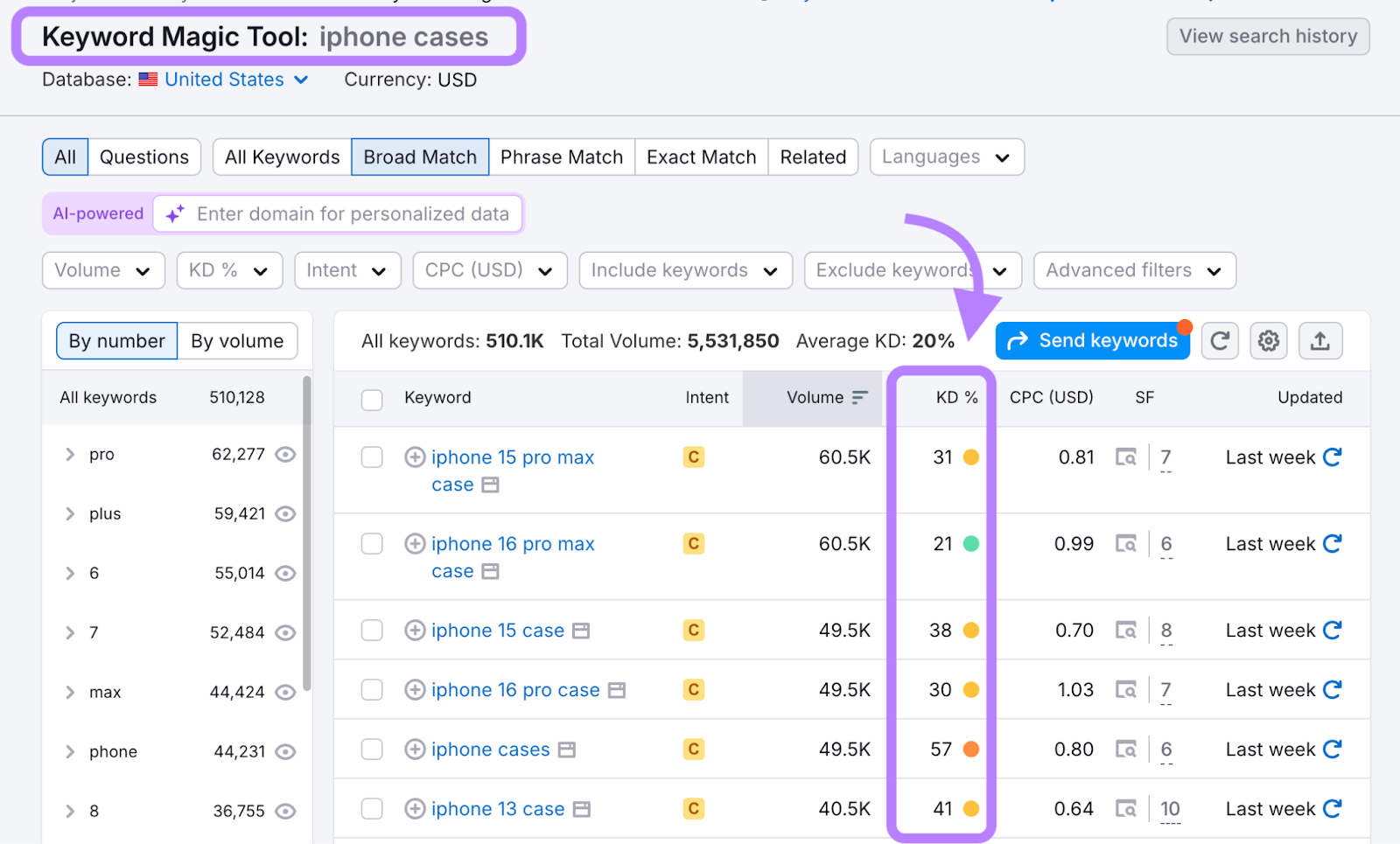
Researching these terms is a great way to spot low-hanging fruit.
Finding the Low-Hanging Fruit in SEO
In SEO, “low-hanging fruit” refers to keywords that many people search for but that not many websites are trying to rank for.
What does that mean for you?
These are easy wins—not too competitive, yet still popular enough to drive traffic to your site.
Focusing on these terms offers a good opportunity to attract visitors organically. Especially if you're launching a new website or entering a new market.
Take it from Alizée Baudez, SEO consultant and digital marketing specialist:
With the Keyword Magic Tool, I like to start by filtering out difficulty scores that are too high. That way, I know my client won’t focus on unreachable keywords … This is a simple way to grab low-hanging fruit and make sure the content plan that we follow will actually be useful to customers.
How to Find Low-Competition Keywords with High Traffic
Finding low-competition terms that are still valuable is easier than you think. Check out this tutorial for some initial tips:

Now, put it into practice with four methods that use Semrush tools:
Step 1. Build a List Using Competitor Keywords
By targeting keywords that your competitors are already ranking for, you can tap into proven markets where there's an existing demand but potentially less competition.
This approach can fast-track your visibility in search results.
Start by using Organic Research to pinpoint terms your competitors are using. Focus on keywords with both high search volume and low difficulty.
Here’s how to do it:
Head to “Organic Research,” enter a competitor’s domain name, and click “Search.”

Click on the “Positions” tab.
Under “Organic Search Positions,” you’ll see the keywords that competitor ranks for in Google's top 100 organic search results.

Take note of the “KD %” column to identify low-competition keywords.

Note: Keep in mind that difficulty ranges are relative to your website's authority and niche. Consider your specific situation when determining which difficulty range to target.
You can then apply filters to narrow down your search. To get a list of low competition keywords with at least 100 monthly searches:
- Set the “Volume” filter to a minimum of "100" (adjust based on your niche)
- Add a filter for “KD %” to target what you consider to be “Easy” keywords
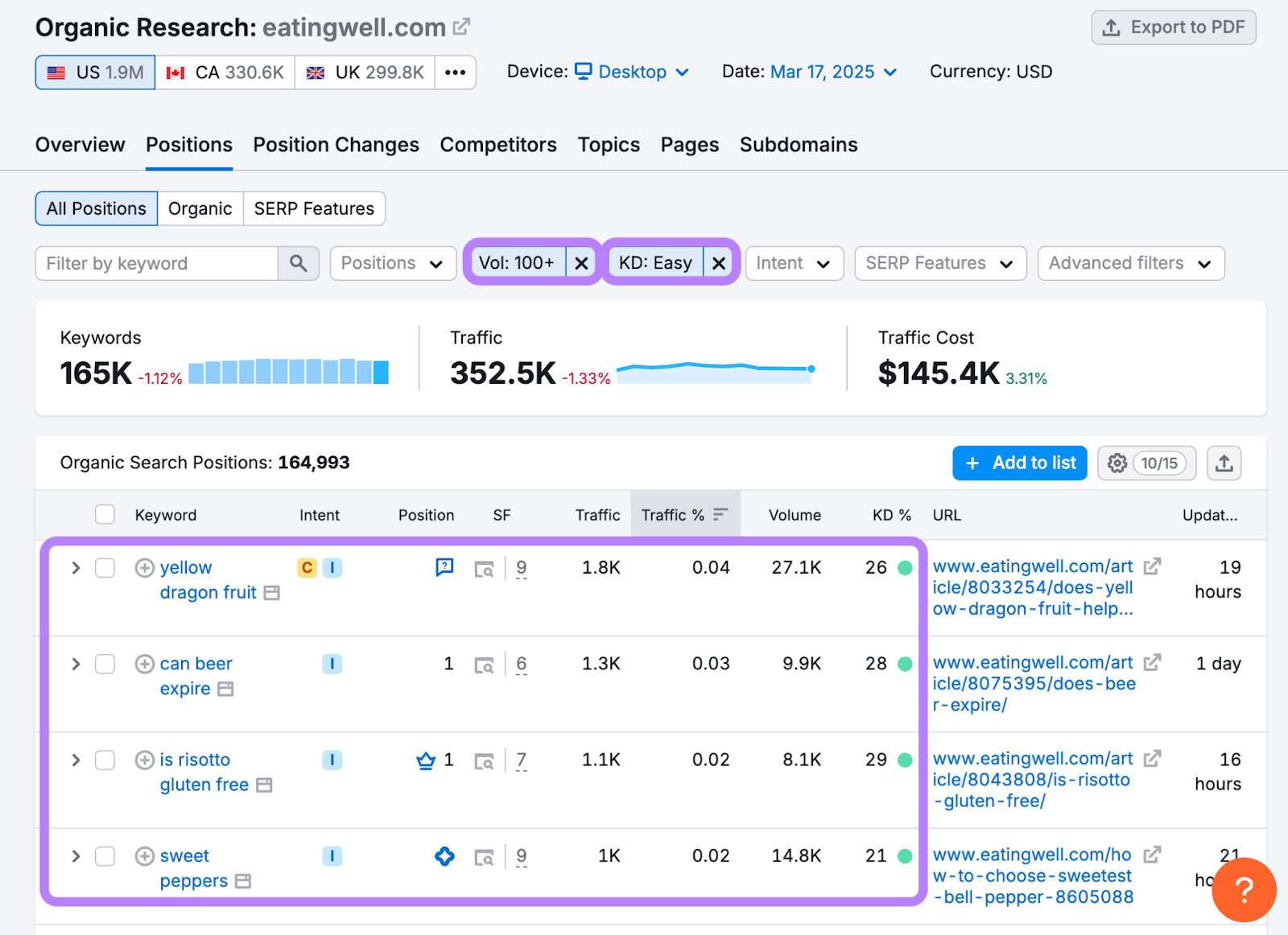
Now, you’re looking at some low-competition options that one of your close competitors is likely benefiting from.
To compare yourself against multiple competitors at once, use Semrush’s Keyword Gap tool.
With this tool, you can easily find missed keyword opportunities that your competition is ranking for but you’re not.
Here’s how:
1. Enter your site, enter up to four of your competitors, and click “Compare”

2. Set your “KD %” to your desired competition level
3. Use the “Missing” filter to find keywords that all your competitors rank for but you don’t
4. Select desired keywords and click “+ Add to keyword list” to add them to a list for later if desired
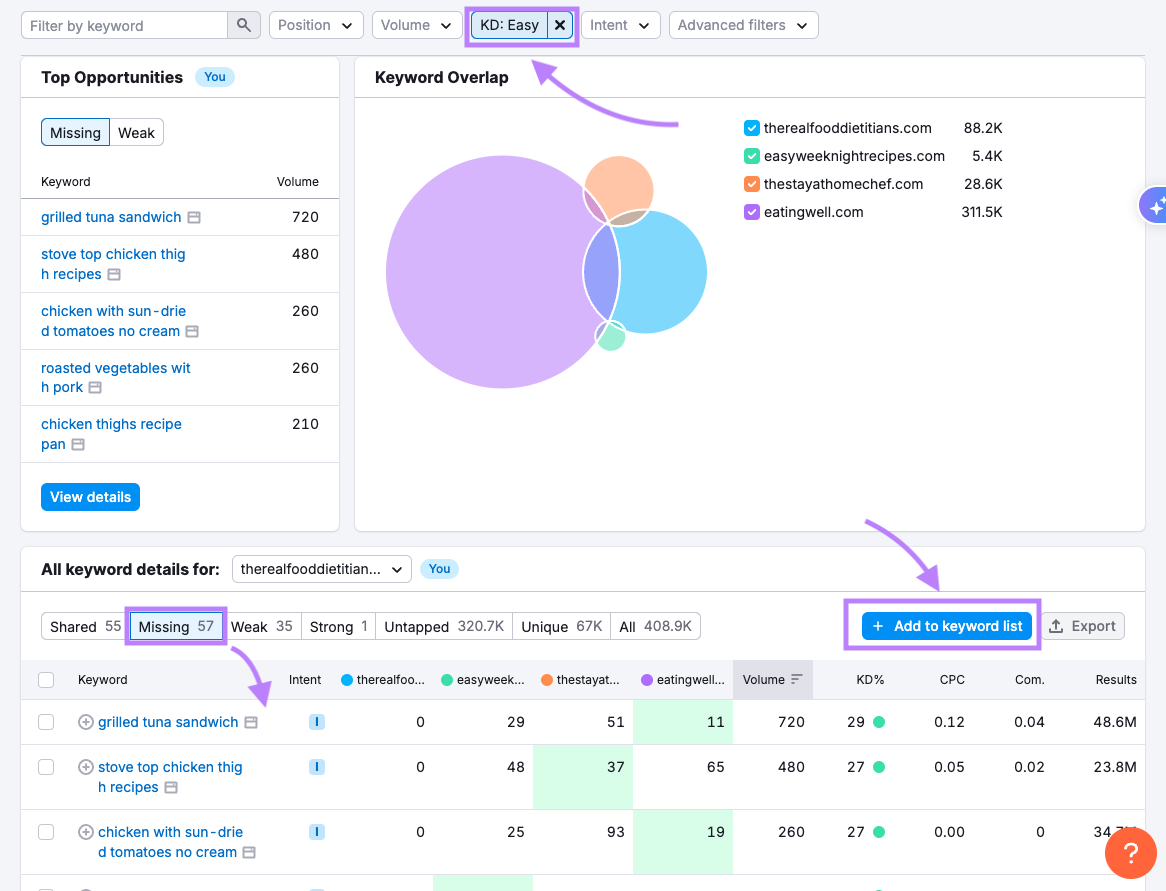
Step 2. Do Additional Keyword Research
Once you have keywords from your competitors, expand your list using the Keyword Magic Tool. This tool helps you discover new keyword ideas based on a single seed term.
To get started, enter a broad term related to your niche (called a seed keyword).
Click “Search.”

You’ll get a list of keywords related to your initial term.

Now, set the “KD %” to your preferred keyword range to adjust your search. So you can focus only on terms you can feasibly rank for.
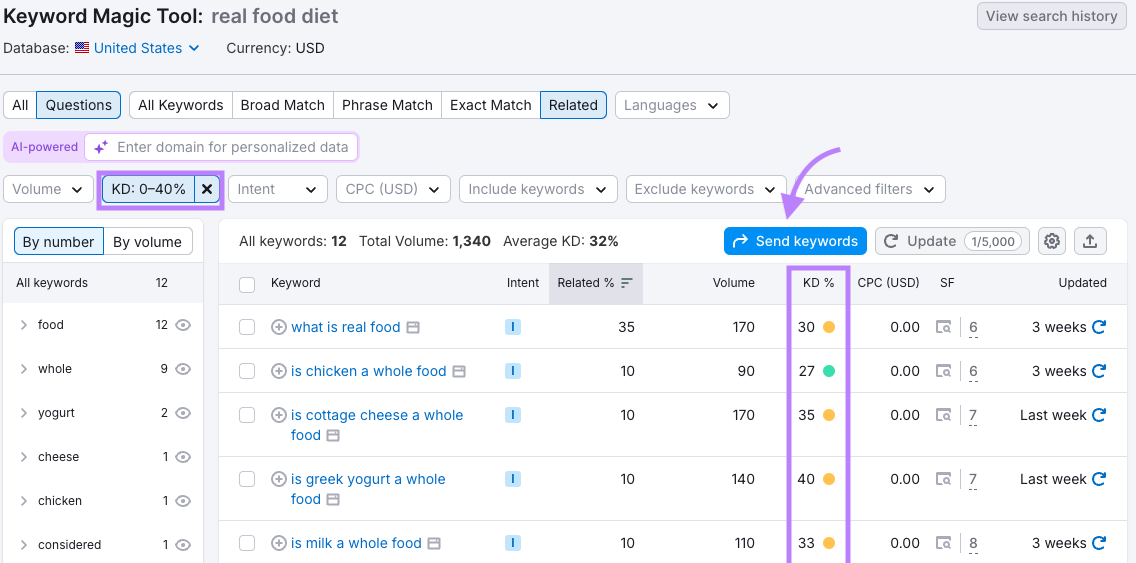
To find terms that searchers are using to ask questions (“what is,” “how to,” etc.), apply the “Questions” filter.

These tools are excellent for finding established keywords.
Step 3. Discover Emerging or Less-Known Keywords
Emerging and less-known keywords are terms that people are talking about but that aren’t necessarily on your or your competitors’ radars.
Targeting these terms can put you ahead of the curve, but they can be challenging to discover since they aren’t always widely used.
To find them, start by going to where your audience is talking to each other:
- Join industry forums and social media groups
- Read comments on relevant YouTube videos
- Visit Q&A sites like Quora and Reddit
Pay attention to how people phrase their questions and problems.
Once you've collected potential keywords, you can use the Keyword Overview tool’s bulk analysis feature to evaluate them. This tool lets you compare up to 100 keywords simultaneously.

The report provides immediate data on search volume, difficulty, SERP features, and more, helping you swiftly determine which keywords are worth further exploration.
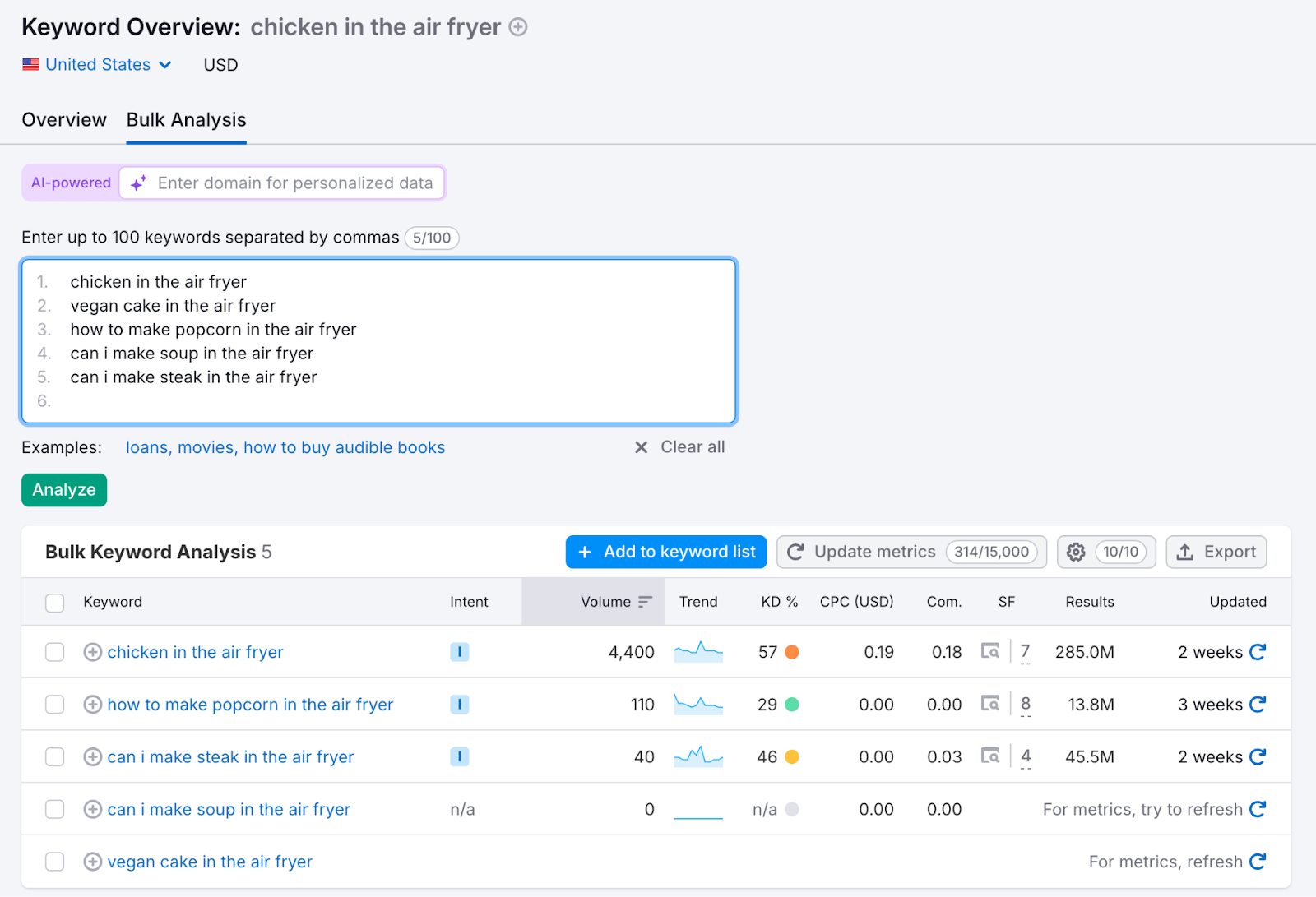
You can identify terms with an upward trend and weed out less promising options to prioritize.
Step 4. Organize Keywords into Content Topics
The Keyword Strategy Builder allows you to do keyword research, group those terms into what are called clusters, and then prioritize them based on terms that have low competition.
Here's how to use it:
Open the tool, enter your seed keywords (up to five), and click “Create list.”

The result is a visual layout of your recommended topics and pages in the “Topical Overview” section. Hover over any topic to see related metrics.

Scroll down to the “Page Details” section. Here, you can use the filters to show recommended topics depending on your goals.
Use the “Easy Start” filter to automatically find page ideas based on low-competition keywords.
To see the keywords for each suggested page, click the corresponding arrow.
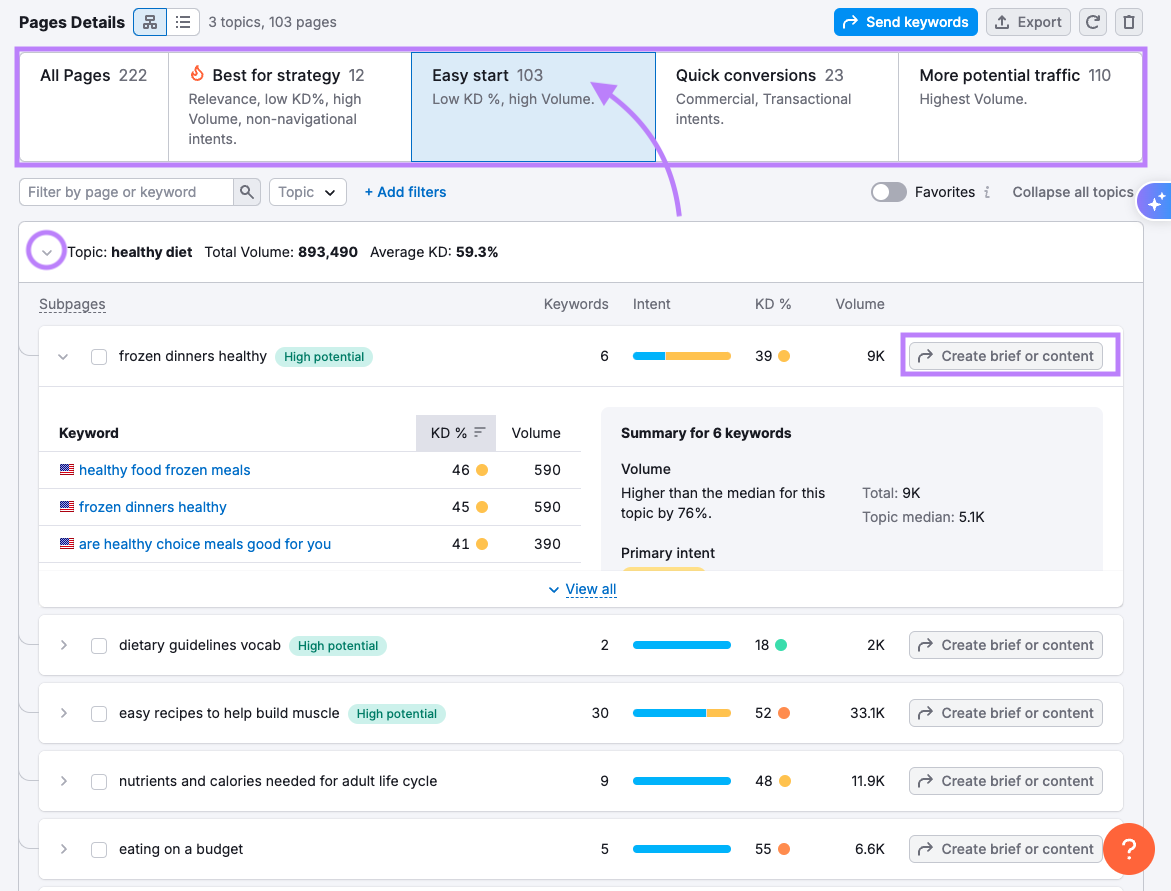
This approach lets you skip the manual steps of keyword research to immediately identify low-competition keyword opportunities relevant to your business.
To translate your research into action, send your desired topics directly to the SEO Writing Assistant or ContentShake AI. Simply click “Create brief or content” to begin.
Other Factors Beyond Keyword Difficulty and Search Volume to Consider
While keyword difficulty and search volume are helpful, some other factors can reveal hidden opportunities or potential pitfalls.
These additional metrics help explain why:
- Some "easy" keywords with low difficulty scores are actually difficult to rank for
- Some seemingly competitive keywords might be within your reach
Let’s go over both of these metrics:
Search Intent
Search intent refers to the reason or purpose behind a user's search query—what they're actually trying to accomplish when they type something into Google.
Even when a keyword relates directly to your products or services and has an attainable difficulty score, the searcher might be looking for something entirely different than what your page offers.
There are four main types of search intent:
- Informational: Searchers are looking for information (how to, what is, etc.)
- Navigational: Searchers are looking for a specific website or page
- Transactional: Searchers are ready to take action( e.g., make a purchase)
- Commercial: Searchers are researching before making a purchase decision
For example, a keyword like "myfitnesspal login" might have low keyword difficulty, but even if you rank for it, those searchers are specifically trying to log into the MyFitnessPal app. Not discover your nutrition service.
On the flip side, a search like "easy meal prep for weight loss" with low competition could be perfect if that's exactly what you have a page on.
Matching your content to the right intent can be the difference between traffic that leaves and traffic that converts.
Cost Per Click (CPC)
Sometimes, terms that have low competition and low search volumes can still be quite valuable.
In this case, check the average cost per click (CPC). A high CPC can indicate that the keyword has strong commercial value.

This is because a high CPC indicates that advertisers are willing to pay more for a term. And advertisers are unlikely to pay more for terms that don’t drive results.
Putting It All Together
Finding low-competition keywords is critical for SEO success, especially for new or smaller websites.
Thankfully, Semrush tools make it easy to find these terms.
For more tips on keyword research with Semrush, check out:
